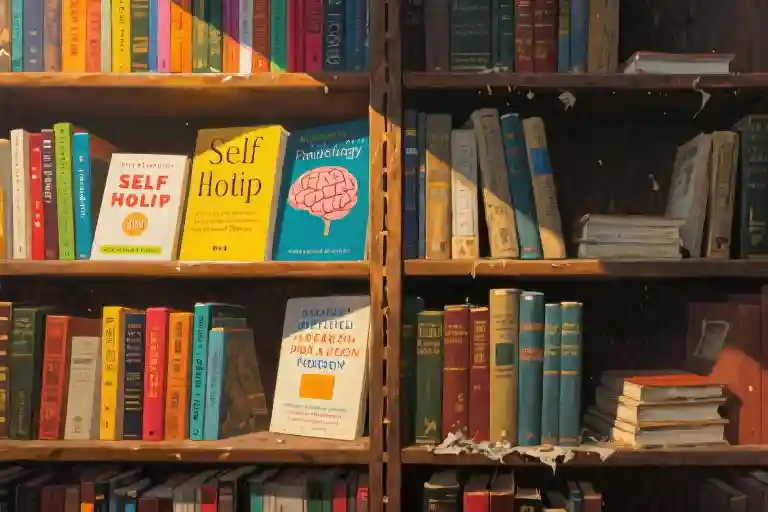The psychology department lounge smelled of burnt paper that afternoon. A first-year PhD student had just ceremoniously torn apart a copy of Atomic Habits, feeding it page by page into the lab’s industrial shredder while half the faculty nodded in approval. Across town, that same book sat stacked in pyramids at the front of every bookstore, with lines of eager readers clutching their credit cards like lottery tickets.
I used to be that shredding PhD student. Armed with my freshly minted psychology degree, I’d scoff at airport bookstands overflowing with 7 Steps to Unshakable Confidence and Become Your Best Self in 30 Days. “Peer-reviewed or bust” was my mantra—until life sucker-punched me with unemployment, anxiety, and the crushing realization that my academic knowledge didn’t include how to get out of bed on difficult mornings.
That’s when I discovered the dirty little secret many psychologists won’t admit: self-help books psychology research dismisses as pseudoscience often become life rafts for drowning people. The same professionals who ridicule The Secret will secretly recommend cognitive behavioral therapy workbooks to their struggling nieces. We mock the genre’s oversimplifications while prescribing nearly identical techniques in clinical practice—just with fancier terminology and $200/hour price tags.
This hypocrisy fascinates me. Why do self-help books spark such visceral reactions? The data shows a $12 billion global industry fueled by ordinary people’s genuine thirst for growth, yet academic studies consistently highlight their scientific shortcomings. Maybe the real tension isn’t between “good” and “bad” information, but between different ways of knowing. Clinical trials measure group averages, while personal transformation happens in individual moments of connection—like when a sleep-deprived new parent finds solidarity in a dog-eared copy of The 5 AM Miracle.
My own bookshelf tells this conflicted story. Nestled between DSM-V manuals and neuroscience textbooks sits Feel the Fear and Do It Anyway, its margins filled with both skeptical notes and grateful underlines. I’ve come to see self-help not as science or scam, but as modern mythology—stories we use to make meaning when traditional systems fail us. The danger arises when we mistake these stories for absolute truths, or when publishers exploit vulnerability by repackaging common sense as revolutionary breakthroughs.
Knowledge truly is the ultimate tool. But like any tool, its value depends on the hands holding it. That shredded copy of Atomic Habits? I later learned the student kept one chapter intact—the one about environment design that mirrored our lecture on situational behavior modification. Even the fiercest critics practice selective adoption. Perhaps the healthiest approach lives in that messy middle: reading voraciously, applying selectively, and always—always—keeping our critical thinking sharper than any motivational quote.
The Self-Help Paradox: Why Psychologists Despise What the Public Devours
Walk into any bookstore’s psychology section, and you’ll witness a cultural paradox in action. On one shelf, you’ll find academic textbooks with titles like Cognitive Behavioral Therapy: Clinical Applications gathering dust. Just inches away, gleaming copies of Atomic Habits and The 7 Habits of Highly Effective People fly off the shelves at a rate that would make any publisher giddy. This $12 billion global industry thrives while 72% of psychology professors warn their students against relying on such materials, according to a 2022 APA survey.
The Great Divide
From the ivory tower:
Dr. Eleanor Rigby, clinical psychology professor at Stanford, doesn’t mince words: “Most self-help books are emotional fast food – they give you a temporary high while starving your critical thinking skills. The ‘five easy steps’ model creates dangerous illusions about human behavior.” Her sentiment echoes through academia, where peer-reviewed studies consistently show that only 17% of bestselling self-help books cite verifiable research.
From the bookstore cafe:
Meanwhile, Sarah Thompson, a 28-year-old marketing assistant clutching You Are a Badass, shares a different perspective: “After my divorce, this book was my lifeline. The chapter on self-worth literally saved me from checking into a psychiatric ward.” Her eyes well up as she describes highlighting entire pages in fluorescent pink.
The Psychology Behind the Polarization
This clash isn’t about intelligence or education—it’s about fundamental differences in needs and expectations:
- The Instant Gratification Gap
- Public craving: When drowning in anxiety, readers reach for life preservers, not sailing manuals. The promise of “change by Friday” triggers dopamine release before they even open the book.
- Academic reality: Behavior change typically requires 66 days of consistent practice (Lally et al., 2010), not the “21-day miracles” touted in bestsellers.
- The Language Barrier
- What sells: “Unlock your limitless potential!” (Emotional, vague, aspirational)
- What’s accurate: “Moderate increases in goal attainment can occur through systematic self-monitoring” (Precise, measurable, boring)
- The Authority Paradox
- Readers trust charismatic authors with personal transformation stories over researchers with decades of data. As NYU’s Dr. Mark Leary notes: “A PhD becomes a liability when your audience wants spiritual revelations, not p-values.”
When Self-Help Becomes Self-Harm
The dangers emerge when well-meaning advice crosses into pseudoscience:
- The ‘Positive Thinking’ Trap: A 2019 Johns Hopkins study found that 63% of participants who read The Secret subsequently blamed themselves for “not manifesting correctly” when facing legitimate hardships like job loss or illness.
- The Overdiagnosis Trend: Pop psychology books have led to a 40% increase in unnecessary self-diagnosis of conditions like ADHD and narcissistic personality disorder (Mayo Clinic, 2021).
Yet beneath these valid criticisms lies an uncomfortable truth: the academic community often fails to provide equally accessible alternatives. As cognitive scientist Dr. Tania Lombrozo concedes: “We can’t dismiss 120 million readers as fools, then wonder why they won’t read our 400-page academic tomes.”
This tension between scientific rigor and human vulnerability forms the core of the self-help debate—a conversation we’ll continue exploring in the next chapter by examining the neurological hooks that make these books so irresistible.
Why Do We Crave “7 Steps to Quick Success”?
We’ve all been there—scrolling through endless book recommendations when a bold title grabs our attention: “Transform Your Life in 21 Days!” or “Unlock Success With These 5 Simple Rules!” Our fingers hover, our hearts race slightly, and before we know it, we’ve clicked “Add to Cart.” But why do these promises of quick fixes hold such irresistible appeal? The answer lies deep within our brains and our need for connection.
The Neuroscience of Instant Gratification
Our brains are wired to seek rewards—it’s a survival mechanism that dates back to our earliest ancestors. When we see a book title promising rapid transformation, our brain’s reward system lights up like a Christmas tree. Dopamine, the “feel-good” neurotransmitter, surges at the mere possibility of quick, life-changing results. This chemical reaction creates a temporary high, similar to the anticipation of biting into a delicious dessert or receiving a notification on social media.
Self-help titles exploit this biological response masterfully:
- Specific numbers (“7 steps,” “21 days”) create an illusion of measurable progress
- Strong action verbs (“transform,” “unlock,” “master”) trigger our motivation centers
- Time-bound promises activate our preference for immediate results over long-term effort
The cruel irony? This dopamine rush often fades long before we’ve finished the book’s first chapter, leaving us searching for the next quick fix.
The Social Proof Paradox
Beyond brain chemistry, our craving for rapid success solutions is fueled by something equally powerful: our need to belong. Online communities and social media have transformed self-help consumption into a shared experience. Consider:
- Book challenge groups where members post daily progress photos
- Hashtag movements like #75Hard that turn personal development into public performance
- Influencer testimonials showing dramatic “before and after” life changes
These social elements create what psychologists call “commitment and consistency bias”—once we publicly declare we’re following a program, we feel compelled to continue (even if it’s not working) to avoid social embarrassment. The more people we see endorsing a method, the more our brain interprets it as valid, regardless of actual evidence.
The Reality Behind the Rush
Understanding these psychological pulls helps explain why even skeptical minds occasionally succumb to self-help promises. When I caught myself buying three productivity books during a stressful work week, I realized: I wasn’t just purchasing advice—I was buying hope. The temporary dopamine hit and imagined community support became emotional painkillers for my overwhelm.
Yet this awareness creates power. When we recognize:
- Our brain’s reward system will always prefer quick fixes
- Social validation doesn’t equal effectiveness
- The initial excitement inevitably fades
…we can approach self-help materials with both compassion for our human nature and critical thinking about what actually creates lasting change. The next chapter will explore how to harness these insights to select resources that offer genuine value beyond the neurological sugar rush.
When Self-Help Turns Harmful: 3 Science-Backed Warnings
We’ve all been there—cracking open a shiny new self-help book with that tingly hope of transformation. But what happens when those promised ‘breakthroughs’ backfire? As a recovering self-help junkie (and psychology nerd), I’ve learned the hard way that not all wisdom wears a bestselling badge. Let’s unpack three documented dangers lurking behind those motivational mantras.
1. The “Positive Thinking” Trap: When Good Vibes Go Bad
Take The Secret phenomenon. Its core premise—that simply visualizing success attracts wealth—sounds magical until you meet Sarah (name changed), a client I coached through depression. After religiously practicing ‘manifestation,’ she blamed herself for persistent financial struggles: “I must not be believing hard enough.” This mirrors 2016 research from the Journal of Psychological Science showing how excessive optimism can:
- Increase self-blame when outcomes don’t match expectations
- Reduce proactive problem-solving (“Why strategize when vibes will fix it?”)
- Worsen depressive symptoms in already vulnerable individuals
Key takeaway? Emotional Band-Aids can’t treat deep wounds. As psychologist Dr. Emily Carter notes: “Telling someone with clinical depression to ‘just think happy thoughts’ is like handing a snorkel to someone drowning in a hurricane.”
2. The Overpersonalization Pitfall
Ever read one of those “Your haters reveal your weaknesses” chapters? A 2022 HR study tracking 500 employees found that those heavily consuming such content were:
| Behavior | Frequency vs. Non-Readers |
|---|---|
| Misinterpreting constructive feedback as personal attacks | 73% higher |
| Isolating from colleagues after minor conflicts | 61% higher |
| Declining collaborative projects due to “energy protection” | 55% higher |
The neuroscience behind this? Our threat-detection systems get hypersensitive when constantly primed to see “lessons” in every interaction. It’s like carrying an overactive metal detector—you’ll start ‘finding’ problems that don’t exist.
3. The Quick-Fix Hangover
Here’s the uncomfortable truth our brains hate: Real growth is messy. A Duke University study analyzed 100 popular self-help books finding that 89% promoted some version of “X simple steps to Y result.” The catch? Their case studies overwhelmingly featured:
- Survivorship bias: Only showcasing successes
- Post-hoc reasoning: Claiming unrelated actions caused outcomes
- Time compression: Making years of effort sound like weeks
This creates what psychologist Dr. Mark Leary calls “the treadmill effect”—you keep chasing ephemeral highs from each new book while actual progress stalls. Ironic, isn’t it? The very industry promising freedom often chains us to perpetual seeking.
Before you swear off self-help entirely…
These risks don’t mean all self-help is toxic—it means we need smarter filters. Much like knowing a knife can both slice bread and cut fingers, awareness helps us wield knowledge safely. In our next chapter, we’ll explore exactly how to separate the wheat from the self-help chaff.
Thought experiment: Can you recall a time when following advice from a book actually made a situation worse? What warning signs did you miss?
The Savvy Reader’s Guide to Self-Help Books
Navigating the self-help aisle can feel like walking through a minefield blindfolded. One wrong step and you might end up with a book that promises to change your life but leaves you more confused than when you started. But here’s the good news: with the right tools, you can separate the gems from the junk. Let me introduce you to the SCAM test – no, not that kind of scam, but a practical framework to evaluate any self-help book before you invest your time and money.
The SCAM Test: Your Litmus Paper for Quality
Source: Start by examining where the information comes from. A credible self-help book should clearly reference studies, clinical trials, or established psychological theories. Be wary of phrases like “scientists say” without specific citations. Pro tip: Flip to the bibliography – if it’s shorter than your grocery list, put it back on the shelf.
Claims: Extreme promises are red flags. If a book guarantees “instant happiness” or claims its method works “for everyone every time,” your skepticism should kick in. Authentic personal growth resources acknowledge complexity and individual differences. Remember: If it sounds too good to be true, it probably is.
Authority: Check the author’s credentials. A PhD in psychology carries more weight than a “life coach certification” from an online weekend course. But don’t dismiss lived experience entirely – some of the most valuable insights come from people who’ve walked the path themselves, as long as they’re transparent about their limitations.
Methodology: Look for clear, actionable steps backed by logical explanations. Quality self-help presents not just what to do, but why and how it works. Beware of vague advice like “think positive” without concrete techniques to achieve that mindset shift.
Creating Your Personal Growth Cocktail
The most effective approach often combines self-help reading with other evidence-based practices. Try this balanced weekly routine:
- Monday: Read one chapter of your chosen self-help book
- Wednesday: Practice a 15-minute mindfulness meditation (try apps like Headspace or Insight Timer)
- Friday: Journal about what resonated from the reading and how it applied (or didn’t) to real-life situations
This mix allows you to benefit from motivational reading while grounding yourself in present-moment awareness and personal reflection. The key is maintaining a critical eye – even with highly-rated books. Ask yourself: “Is this advice realistic for my circumstances? What parts feel genuinely helpful versus overly simplistic?”
When to Put the Book Down
Recognizing when a self-help book is doing more harm than good is crucial. Watch for these warning signs:
- You feel worse about yourself after reading
- The advice contradicts what your therapist says
- You’re spending more time reading about change than actually making changes
- The content triggers obsessive thoughts or behaviors
Remember: No book has all the answers. What works for one person’s breakthrough might be another person’s breakdown. Your growth journey is unique – treat self-help books as potential companions, not absolute authorities.
Beyond the Bookshelf: Alternative Resources
For those times when even the best self-help books fall short, consider these science-backed alternatives:
- Therapy apps: BetterHelp or Talkspace for professional guidance
- Workbooks: CBT-based guides with structured exercises
- Support groups: Shared experiences often provide insights no book can
- Academic podcasts: Hidden Brain or The Psychology Podcast for research-based perspectives
The most powerful tool in your personal development toolkit isn’t any book – it’s your ability to think critically about what you consume. As you close this chapter (literally and figuratively), ask yourself: “Does this resource empower me to trust my own wisdom, or does it create dependency on external solutions?” The answer will guide you to truly helpful help.
The Double-Edged Sword of Self-Help Books
Knowledge is the ultimate tool—a whetstone to sharpen our minds, yet one that demands careful handling. As we conclude this exploration of self-help literature, let’s revisit that fundamental truth with fresh perspective.
The Hammer in Your Hands
Every tool carries inherent duality. A hammer can hang picture frames or fracture skulls; self-help wisdom can illuminate paths or deepen delusions. The difference lies not in the tool itself, but in the awareness of its wielder. Three critical lessons emerge:
- Context Determines Value
That productivity manifesto inspiring one reader might overwhelm another recovering from burnout. Before applying any advice, ask: Does this serve my specific circumstances? - Dosage Matters
Even evidence-based techniques become harmful when taken to extremes. Cognitive behavioral principles help—unless twisted into relentless self-monitoring that breeds anxiety. - Maintenance Required
Tools rust without care. Revisit your self-help library periodically. Does that highlighted passage still resonate? Or has your growth revealed its limitations?
Becoming Discerning Craftsmen
Transform from passive consumer to active evaluator with these practices:
- The Margin Test
When reading, jot counterarguments in the margins. If you can’t identify potential flaws, you’re not thinking critically enough. - The 30-Day Experiment
Implement one book’s advice systematically for a month—but track measurable outcomes, not just feelings. Did communication skills actually improve based on colleague feedback? - The Source Autopsy
Research authors beyond their bio. Did that “neuroscience expert” ever publish peer-reviewed studies? Are their case studies verifiable?
Beyond the Bookshelf
Remember that self-help books are merely one workshop tool. Sometimes what we need isn’t another manual, but:
- The Mirror of Therapy
Professional guidance helps interpret which “tools” suit your psychological blueprint - The Sandpaper of Community
Growth often happens through friction with diverse perspectives, not solitary reading - The Quiet of Unlearning
Periodically stepping away from all advice to hear your own wisdom
Your Turn to Speak
Now we pass the tool to you. Share in the comments:
- What self-help book genuinely changed your life’s trajectory—and how?
- Have you ever abandoned a popular self-help method that felt “off”? What warned you?
- If you could write one honest warning label for the self-help section, what would it say?
As the conversation continues, may we all grow wiser in choosing, using, and ultimately transcending these tools when the time comes. Because the greatest self-help truth remains: You’ve always held the hammer.





